Abstract
This paper introduces a new strategy of frequency estimation for grid-tied and stand-alone mode AC/DC power converters. Frequency stabilization is required, especially when operating in stand-alone mode with a Droop Control strategy, or in hybrid mode with a Diesel generator. It is also required to reduce or increase power output along with grid frequency changes. The novel strategy utilizes a resonant filter to estimate the frequency of the voltage grid and is referenced as a resonant-frequency-estimator (RFE). A mathematical background is presented for the proposed estimator and its performance is evaluated. It is compared with three common frequency estimation algorithms: SRF-FLL, DDSRF-FLL, and DSOGI-FLL. Results are presented for three cases: frequency swing, harmonics injection, and type B short-circuit. Results are analyzed and the conclusion shows that the proposed novel strategy has comparable parameters to commonly used frequency estimation algorithms while having a loopless structure.
1. Introduction
The popularization of renewable energy sources, especially photovoltaic panels, while benefiting households, also created a problem with managing the utility grid. As a response, the grid operators introduced restrictions to keep household energy production within allowable, safe limits. All grid-tied inverters have to track frequency, phase, and amplitude of the grid voltage and behave accordingly; the EU Commission Regulation 2016/631 (14 April 2016) introduced, among other codes, LFSM-O mode, in which the generated active power decreases in response to an increase in frequency above a predefined threshold value, or when stand-alone mode is detected. In the case of a microgrid [1,2], the problem of maintaining voltage parameters escalates [3].
Such a system has a natural tendency to fluctuate the frequency as the Diesel generator cannot maintain stable output while under small loads, so it is usually supported by an AC/DC power converter and an energy storage (Figure 1) which will load the generator accordingly in order to maintain stable frequency output [4,5]. A microgrid such as this is a system with relatively high impedance and consequently low short-circuit power [6]. This, in addition, causes voltage to be prone to distortions caused by current harmonics, rendering the frequency estimation even more difficult.
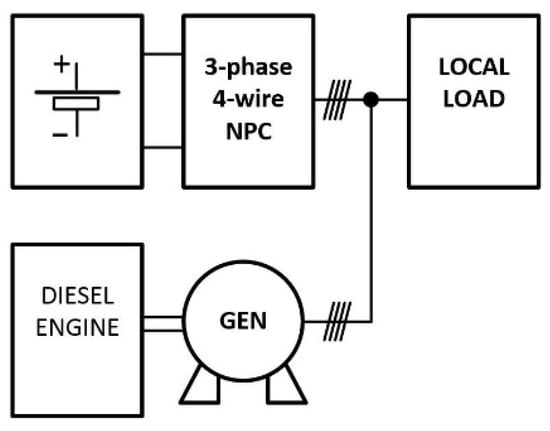
Figure 1.
Microgrid with Diesel generator and an energy storage.
Microgrid operating inverters can be divided into three categories: grid feeding, grid forming, and grid supporting [7]. Out of the three, only the latter can fulfill the roles of the other two: can both create a voltage reference value and become the reference point for other inverters in a microgrid, or slave off another energy source (e.g., a Diesel generator) and work as a current source [6]. Figure 2 presents the basic concept of a grid supporting algorithm known as Droop Control [8]. The commonly used voltage-oriented control algorithm (VOC) [9,10] falls into grid feeding category. The Droop Control algorithm extends the capabilities of the VOC algorithm [11]. Based on measured currents and voltages, apparent power is calculated and compared against reference values. In order to estimate power demand correctly, an accurate grid frequency estimation algorithm is required.

Figure 2.
Droop Control of a Grid-Tied Inverter, where: P*, Q*—reference value of active, reactive power; E*, ω*—reference value of output voltage and system angular frequency; Vd, Vq—active and reactive voltage; ωg, θg—real value of system angular frequency and phase angle; igabc, vgabc—the instantaneous value of phase current and voltage; Kp, Kq—the droop coefficients; Dabc—inverter duty cycle; and L—output filter induction.
Many of the algorithms used to estimate the frequency of the electric power systems are based on the assumption that the fundamental frequency is practically constant, or that it experiences only minor variations—especially those methods that are based on the Fast Fourier Transform (FFT) [12]. Another group of frequency estimation algorithms is operating in an open-loop scheme [13]: the estimation is based on delaying the measured signal by a set amount of time and comparing it with the actual value of a measured signal. This group is not resistant to distortions such as harmonics, and requires additional filtering with steep-slope characteristics [14] or predictive filtering [15]. A group most commonly used in frequency estimation is the closed-loop group—the phase-locked loop systems. These methods estimate frequency indirectly. The main task of phase-locked loop systems [16] is precise calculation of the grid angle, while the frequency value is recovered from the signal driving the voltage-controlled oscillator (VOC) generator. These methods are highly effective as, along with basic PLL system, other improvements are used, such as the symmetrical components decoupling.
The most common algorithms are FLL-SOGI (frequency-locked loop second order generalized integrator) [17,18] and SRF-PLL (synchronous reference frame phase-locked loop) [19]. FLL-SOGI algorithm is more robust and immune to grid disturbances when compared to SRF-PLL, however, this comes at the cost of increased response delay to rapid frequency changes. Due to this, a novel algorithm of resonant frequency estimation was proposed, based on a resonant filter and a signal scaling model. The algorithm has a loopless form and has a performance comparable with the most advanced frequency locked loop algorithms.
2. Frequency Estimation Algorithms
2.1. Synchronous Reference Frame (SRF–PLL)
The Synchronous Reference Frame PLL algorithm utilizes mathematical transformations in order to extract the grid angle information. First, a three-phase stationary reference system (1) is transformed into a two-phase stationary reference system using Clarke transform (2), which is then released from constraints and rotates with the grid angle, using Park transform (3) [20].
Compared against reference voltage vq, it produces the grid angular frequency and, further, the grid angle (Figure 3).

Figure 3.
SRF-PLL algorithm.
The transfer function of SRF-FLL (Figure 3) can be expressed as a second order equation in normalized form with help of a damping factor and a natural frequency .
The natural frequency and damping factor can be expressed as a function of PLL gain and integration time and vice versa:
where is a constant damping factor 0.707 [18].
2.2. Double Decoupled Synchronous Reference Frame (DDSRF–FLL)
Similar to the previous SRF-FLL approach, the DDSRF–FLL uses coordinate transformation from the three-phase stationary system into the two-phase orthogonal rotating system. This method, however, performs an additional decoupling and is able to split the grid voltage signals into positive and negative components (9) [21] (Figure 4).

Figure 4.
DDSRF-FLL algorithm.
This is achieved by splitting the Clarke and Park transformation into two separate transformations, for positive and negative sequences (10)–(12).
Taking the Clarke transform and ignoring the zero component and the zero sequence
then taking the Park transform using the angle locked by the PLL for the positive sequence:
The decoupled value for DDSRF-FLL synchronisation system is:
Further, the frequency and angle estimation is performed as in the SRF–FLL algorithm (Figure 3). At the cost of an increased number of computations and longer processing time, robustness is increased, and the system is able to estimate frequency and synchronization angle even in the presence of asymmetrical voltages.
2.3. Double Second Order Generalized Integrator FLL (DSOGI-FLL)
An alternative solution to the one mentioned previously is Double Second Order Generalized Integrator PLL (Figure 5). It is also able to remove the negative voltage component from the voltage, but it does so by filtering the signals in the αβ stationary coordinates. The filtrations are carried out using two resonant filters shifted to each other by 90° angle, which removes the negative voltage component. The SOGI-FLL is composed of two blocks, the SOGI-QSG, which is a second-order adaptive filter, and can generate properly filtered in-phase and quadrature phase components (v_α and v_β) of a given input voltage. The transfer function SOGI-FLL can be expressed as two second order equations:
where ’ is the estimated frequency, s is the Laplace operator, k = 0.8, and T = 50 is the FLL positive gain.
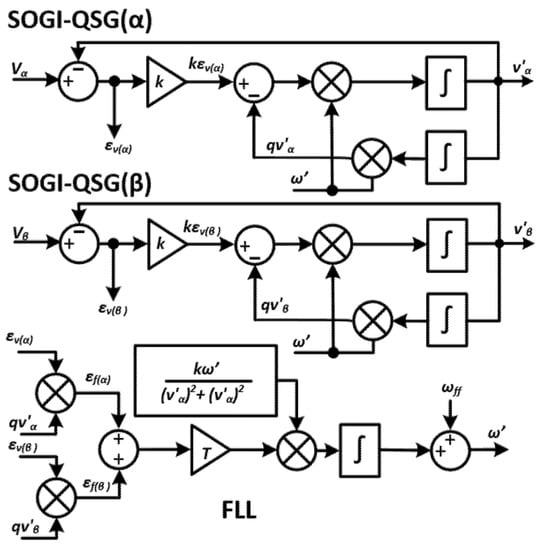
Figure 5.
DSOGI-FLL algorithm, where: qV’α and qV’β—signals in quadrature phase.
In the next step, the phase and quadrature-phase components are multiplied by each other. The sum of components is normalized by two constant factors and integrated. The frequency estimated in that way is extremely stable when compared with other presented methods of frequency estimations, even in the presence of voltage disturbances. This high stability is coming at the cost of a slow response to the quick-changing input signal.
2.4. Resonant Frequency Estimator (RFE)
In this paper, we propose a new method of simple and quick estimation of input voltage frequency. The proposed system can be divided into three major components (Figure 6). The first is a three-phase into two-phase orthogonal system conversion. Next, using high-pass filters, higher order harmonics are filtered out and then subtracted from the original signals, leaving only the base component. The following part scales the signals into per-unit values, decoupling the frequency signal from any voltage disturbances. Next, notch filters are used to condition the output signals. Based on the frequency deviation, these signals will be damped. Thanks to the decoupling of frequency and amplitude of the voltage, the difference between input and output signals of notch filters is caused only by the filter damping, and not by voltage amplitude changes. This ensures that the signal output value is only affected by the frequency deviation.
where are gain factors.

Figure 6.
Resonant frequency estimator algorithm, where HPS—high pass filter and NF—notch filter.
The resonant frequency of a notch filter cannot match the nominal frequency of the grid; it has to be either slightly higher or slightly lower. If the former was the case, the algorithm would require additional components to detect if the frequency had dropped or risen.
Shifting the frequency to either side causes the filter to always operate higher than its resonant frequency, except for larger drops, in which case the inverter should shut down anyway. It is also imperative to tune the notch filter so the allowable changes in frequency cause the output signal to move along the linear part of the magnitude curve (Figure 7). Setting the resonant frequency of the filter f1 to 42 Hz ensures that, by the time the inverter reaches this point, detected frequency deviation has caused it to shut down.
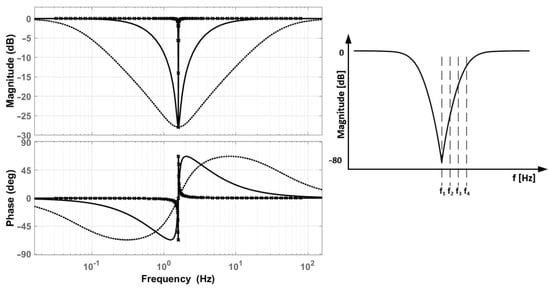
Figure 7.
The Bode diagram of the notch filter (left), where ξ1 and ξ2 are multiplied by a factor a1 = 0.1, a2 = 1, and a3 = 10; Notch filter frequency curve (right) with frequencies: f1 = 42 Hz, f2 = 45 Hz, f3 = 50 Hz, and f4 = 55 Hz.
3. Frequency Estimation Testing
To analyze the behavior of RFE, a series of tests were concluded comparing this frequency estimation algorithm with FLL, SRF-FLL, and DDSRF-FLL. For research, three test cases were selected:
- (a)
- 10% frequency swing;
- (b)
- Higher harmonics injection;
- (c)
- Single-phase short circuit.
The test bench consisted of a controllable three-phase voltage source Chroma 61511 (Lublin University of Technology, Lublin, Poland), a load, a digital oscilloscope Tektronix MSO5034B (Lublin University of Technology, Lublin, Poland) and a real-time system dSPACE DS1102 (Lublin University of Technology, Lublin, Poland). The dSPACE platform was used to implement the algorithms developed in Matlab/Simulink software (Lublin University of Technology, Lublin, Poland). All four algorithms were developed and tested for three cases typical for the utility grid. The analog-digital converters of the dSPACE platform were connected to the voltage source through Hall-effect based voltage sensors (LEM LV25-P) (Figure 8). The voltage source was used to generate the test cases, while the output of the estimation algorithms was observed in the real-time system. The oscilloscope was also used as an auxiliary voltage signal logging system. The test case parameters, as well as the critical algorithm coefficients, are presented in Appendix A. The RMS error value presented in figures in this section was calculated as RMS value of the frequency error (Δf) over fundamental frequency of the grid.

Figure 8.
Test bench diagram.
3.1. Frequency Swing
Frequency swing test was performed with ±3 Hz limits (Figure 9 and Figure 10). Higher frequency oscillations are a rare occurrence in the grid [22] and qualify for emergency action. SRF-FLL-based algorithms are more accurate than RFE and FLL in stable conditions. Initial oscillations are present in all four algorithms. The resonant estimation algorithm is an improvement over DSOGI-FLL, as it is much faster and less prone to oscillations.
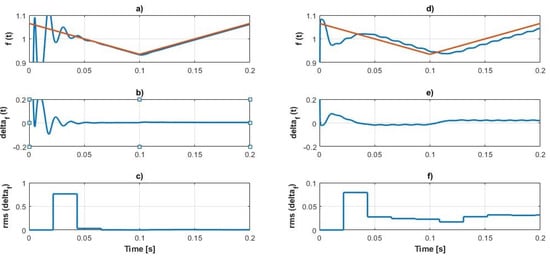
Figure 9.
Frequency swing for ±3 Hz deviation and slew rate 60 Hz/s. DDSRF-FLL (a–c) and DSOGI-FLL (d–f), where: (a,d) frequency estimated value (orange—reference, blue—tested algorithm), (b,e) frequency error between compared algorithms, and (c,f) RMS value-form frequency error.
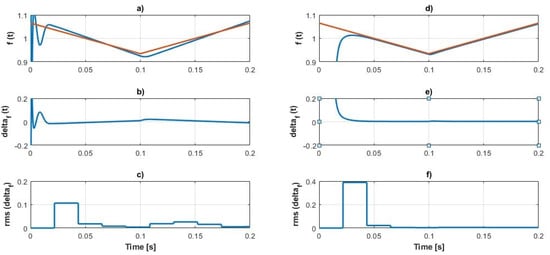
Figure 10.
Frequency swing for ±3 Hz deviation and slew rate 60 Hz/s. RFE (a–c) and SRF-FLL (d–f), where: (a,d) frequency estimated value (orange—reference, blue—tested algorithm), (b,e) frequency error between compared algorithms, and (c,f) RMS value-form frequency error.
The results for the frequency swing in range of ±3 Hz and slew rate of 60 Hz/s presented in Figure 9 and Figure 10 show that the fastest of the algorithms is the SRF-FLL (Figure 9d). Despite large (0.4 pu) initial error, this algorithm reaches close to zero error in about 0.07 s. The novel RFE algorithm (Figure 9a–c) shows similar properties to DSOGI-FLL (Figure 9d–f); however, after an initial error, it stabilizes and tracks frequency more accurately than the DSOGI-FLL. Additionally, it does not generate any oscillations, which are present in case of the DSOGI-FLL.
3.2. Harmonics Injection
A harmonics test was performed by connecting a three-phase rectifier with PFC to the controllable source. This type of load emulates the most common load type connected to the grid, and forces typical harmonics present in the utility grid to flow (Figure 11 and Figure 12). It is clear that both SRF-based algorithms are prone to harmonic distortion, while DSOGI-FLL is almost immune to them. However, DSOGI-FLL is significantly slower. The resonant estimator RFE shows much less oscillation in estimated frequency in presence of harmonics compared to the first two algorithms; however, it is still worse than DSOGI-FLL-based estimation.
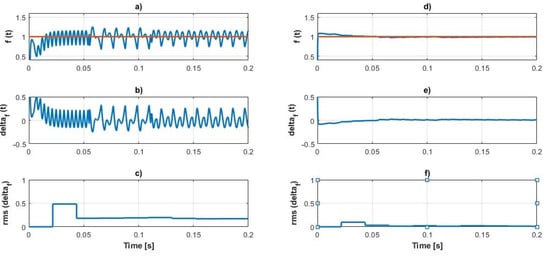
Figure 11.
Frequency estimation in presence of harmonics for DDSRF-FLL (a–c) and DSOGI-FLL (d–f) where: (a,d) frequency estimated value (orange—reference, blue—tested algorithm), (b,e) frequency error between compared algorithms, and (c,f) RMS value-form frequency error.
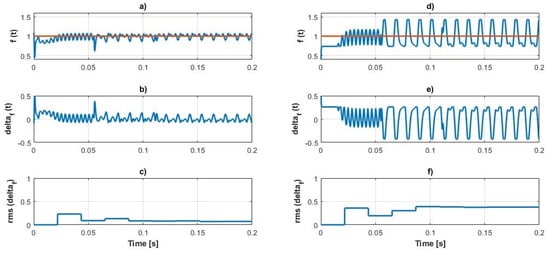
Figure 12.
Frequency estimation in presence of harmonics for RFE-FLL (a–c) and SRF-FLL (d–f) where: (a,d) frequency estimated value (orange—reference, blue—tested algorithm), (b,e) frequency error between compared algorithms, and (c,f) RMS value-form frequency error.
The results for frequency estimation in the presence of harmonics presented in Figure 10 and Figure 11 show that the DSOGI-FLL is the most robust and immune to distortions (Figure 10d–f). The RFE algorithm shows similar properties (Figure 11a–c). The RMS value of the frequency error reached 0.11 (Figure 11c) which, in comparison to SRF-FLL (0.33), is an excellent result. In the case of two of the algorithms (SRF-FLL and DDSRF-FLL) there is a significant initial error which is absent in case of the RFE. The lack of this initial behavior in the case of RFE is caused by the absence of a loop in the structure of this algorithm. In case of all algorithms their reaction can be divided into three parts: the startup, stabilization, and the stable operation, and in case of the RFE, the SRF-FLL, and the DDSRF-FLL algorithms, those periods have similar timing. The DSOGI-FLL proves absolutely immune to the harmonic distortion.
3.3. Asymmetrical Short-Circuit
A single-phase short circuit is an event in a four-wire network when any phase wire is directly connected to the neutral line. It is an asymmetric event of type B [23,24]. For this type of transient short circuit, the operating conditions must be maintained for the time specified in the FRT codes of the grid operator. A voltage observed by an inverter loses signal in one phase (Figure 13), making frequency estimation, grid synchronization, and stable operation of the inverter significantly harder. For this test, DSOGI-FLL shows the best performance, as there is only a minor deviation in the estimated frequency right after short circuit occurs (Figure 14 and Figure 15). SRF-FLL also stabilizes rapidly, but has greater initial deviation. Both RFE and DDSRF-FLL oscillate after short circuit event, with RFE’s oscillation magnitude being several times lower. The DSOGI-FLL and the DDSRF algorithm provide the best frequency tracking in case of an asymmetrical short circuit. This can be explained by their structure: those algorithms utilize the symmetric component decomposition, and are synchronizing only to the positive sequence. In case of short circuit event, a large negative sequence component appears in the grid, which is ignored by those two algorithms. Another noticeable behavior is that in case of SRF-FLL and RFE, the error caused by the short circuit event is similar in both shape and magnitude to the initial startup error.

Figure 13.
The L2 line short circuit to neutral wire.
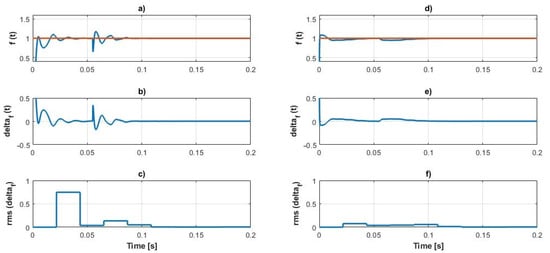
Figure 14.
Frequency estimation during short-circuit for DDSRF–FLL (a–c) and DSOGI-FLL (d–f) where: (a,d) frequency estimated value (orange—reference, blue—tested algorithm), (b,e) frequency error between compared algorithms, and (c,f) RMS value-form frequency error.
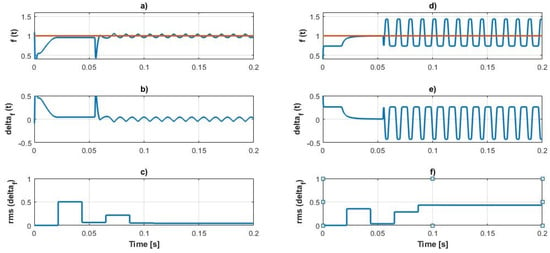
Figure 15.
Frequency estimation during short circuit for RFE (a–c) and for SRF-FLL (d–f) where: (a,d) frequency estimated value (orange—reference, blue—tested algorithm), (b,e) frequency error between compared algorithms, and (c,f) RMS value-form frequency error.
4. Conclusions
This paper presents a novel grid frequency estimation algorithm based on resonant filtering called resonant frequency estimator (RFE). To provide comparison with commonly used frequency estimators in the utility grid, the three well established algorithms are presented: SRF-FLL, DDSRF-FLL, and DSOGI-FLL. The algorithms were considered in a situation where a grid would operate in an island state; where, as a source of frequency deviation, a Diesel generator connected in parallel to renewable energy sources could be used. The behavior of such a grid was emulated by the programmable three-phase voltage source. A real time system was used to implement and test all four described algorithms in three cases: a 10% frequency swing, presence of higher grid harmonics and asymmetric short circuit. The selection was based on the probability of occurrence of these events in the grid. When comparing the results, the most robust and precise algorithm was DSOGI-FLL (Table 1). It shows the best performance, which is also confirmed when taking into account average error values.

Table 1.
Comparison of four frequency estimation algorithms.
The RFE algorithm introduced by the authors shows promising results, being only slightly worse than the DSOGI-FLL in two out of three test cases (frequency swing and harmonics injection) and relatively accurate in case of a short circuit. The novel algorithm shows potential, as it retains good accuracy of frequency estimation in both static and dynamic states (Figure 16), while being simpler than other three tested algorithms.
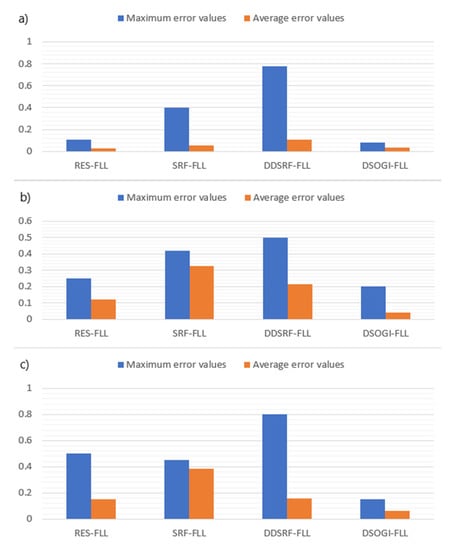
Figure 16.
Comparison of maximum and average error values for (a) frequency swing, (b) harmonics injection, and (c) type B short-circuit.
Author Contributions
Conceptualization, D.Z.; methodology, D.Z.; software, K.F.; validation, D.Z. and K.F.; formal analysis, D.Z.; investigation, D.Z. and K.F.; resources, D.Z.; data curation, D.Z. and K.F.; writing—original draft preparation, D.Z. and K.F.; writing—review and editing, D.Z. and K.F.; visualization, D.Z. and K.F.; and supervision, D.Z. All authors have read and agreed to the published version of the manuscript.
Funding
This research received no external funding.
Institutional Review Board Statement
Not applicable.
Informed Consent Statement
Not applicable.
Acknowledgments
This work was supported by Lublin University of Technology, Grant No FP-2/EE.
Conflicts of Interest
The authors declare no conflict of interest.
Appendix A. Details of the Test Conditions
The appendix describes the details of the test conditions performed in the laboratory testing as described in Section 3. Additionally, all critical control loop parameters are presented; however, these parameters may require adjustment for the specific hardware platform. The presented algorithms were implemented on a dSPACE DS1202 real time system. The software was developed using Matlab and Simulink, and implemented directly in this form on the real time system.

Table A1.
Test condition summary.
Table A1.
Test condition summary.
| Frequency Swing |
| High frequency: 53 Hz |
| Low frequency: 47 Hz |
| Frequency change rate: ±60 Hz/s |
| Harmonics injection |
| Harmonic frequency: 250 Hz, 350 Hz |
| Total harmonic distortion: 43% of 5th harmonic, 18% of 7th harmonic |
| Asymmetric short-circuit |
| An asymmetric short-circuit was emulated by disconnecting one of voltage measurements from the circuit (resulting in phase voltage readout Vphase = 0 V). |

Table A2.
Frequency estimation algorithm parameters.
Table A2.
Frequency estimation algorithm parameters.
| SRF-FLL |
| Damping factor ξ = 0.707 |
| Natural frequency ωn = 50 Hz |
| DDSRF-FLL |
| Damping factor ξ = 0.707 |
| Natural frequency ωn = 50 Hz |
| DSOGI-FLL |
| Natural frequency ω = 50 Hz |
| Damping factor k = 0.8 |
| Settling time T = 50 |
| RFE |
| Damping factor ξ1 = 0.001 |
| Damping factor ξ2 = 0.1 |
| Resonant frequency ωn = 42 Hz |
References
- Dragicevic, T.; Alhasheem, M.; Lu, M.; Blaabjerg, F. Improved model predictive control for high voltage quality in microgrid applications. In Proceedings of the Energy Conversion Congress and Exposition (ECCE), Cincinnati, OH, USA, 1–5 October 2017; pp. 4475–4480. [Google Scholar]
- Milczarek, A.; Malinowski, M.; Guerrero, J.M. Reactive power management in islanded microgrid-proportional power sharing in hierarchical droop control. IEEE Trans. Smart Grid 2015, 6, 1631–1638. [Google Scholar] [CrossRef] [Green Version]
- Zhou, J.; Cheng, P.T. A modified Q-V droop control for accurate reactive power sharing in distributed generation microgrid. IEEE Trans. Ind. Appl. 2019, 55, 4100–4109. [Google Scholar] [CrossRef]
- Bałkowiec, T.; Koczara, W.; Moskwa, M. Island operation of a three phase adjustable speed generation system. Int. Trans. Electr. Energy Syst. 2019, 29, e2748. [Google Scholar] [CrossRef]
- Iwański, G.; Bigorajski, Ł.; Koczara, W. Speed control with incremental algorithm of minimum fuel consumption tracking for variable speed diesel generator. Energy Convers. Manag. 2018, 161, 182–192. [Google Scholar] [CrossRef]
- Muljadi, E.; Samaan, N.; Gevorgian, V.; Pasupulati, J. Different factors affecting short circuit behavior of a wind power plant. IEEE Trans. Ind. Appl. 2013, 49, 284–292. [Google Scholar] [CrossRef]
- Labella, A.; Filipovic, F.; Petronijevic, M.; Bonfiglio, A.; Procopio, R. An MPC Approach for Grid-Forming Inverters: Theory and Experiment. Energies 2020, 13, 2270. [Google Scholar] [CrossRef]
- Arul, P.; Ramachandaramurthy; Rajkumar, V.R. Control strategies for a hybrid renewable energy system. Renew. Sustain. Energy Rev. 2015, 42, 597–608. [Google Scholar] [CrossRef]
- Yang, Y.; Blaabjerg, F.; Zou, Z. Benchmarking of grid fault modes in single-phase grid-connected photovoltaic systems. IEEE Trans Ind. Appl. 2013, 49, 2167–2176. [Google Scholar] [CrossRef]
- Luna, A.; Citro, C.; Gavriluta, J.; Hermoso, J.; Candela, I.; Rodriguez, P. Advanced PLL structures for grid synchronization in distributed generation. Renew. Energy Power Qual. J. 2012, 1747–1756. [Google Scholar] [CrossRef]
- Vasquez, J.C.; Guerrero, J.M.; Savaghebi, M.; Eloy-Garcia, J.; Teodorescu, R. Modeling, Analysis and Design of Stationary-Reference Frame Droop-Controlled Parallel Three-Phase Voltage Source Inverters. IEEE Trans. Ind. Electron. 2014, 60, 1271–1280. [Google Scholar] [CrossRef] [Green Version]
- Wen, H.; Guo, S.; Teng, Z.; Li, S.; Yang, Y. Frequency estimation of distorted and noisy signals in power systems by FFT-based approach. IEEE Trans. Power Syst. 2014, 29, 765–774. [Google Scholar] [CrossRef]
- Freijedo, F.; Doval-Gandoy, J.; López, Ó. A Generic Open-Loop Algorithm for Three-Phase Grid Voltage/Current Synchronization With Particular Reference to Phase, Frequency, and Amplitude Estimation. IEEE Trans. Power Electron. 2009, 24, 94–107. [Google Scholar] [CrossRef]
- Xiao, F.; Dong, L.; Xiaozhong, L. A Novel Open-Loop Frequency Estimation Method for Single-Phase Grid Synchronization Under Distorted Conditions. IEEE J. Emerg. Sel. Top. Power Electron. 2017, 5, 1287–1297. [Google Scholar] [CrossRef]
- Xia, Y.; Douglas, S.; Mandic, D. Adaptive Frequency Estimation in Smart Grid Applications: Exploiting Noncircularity and Widely Linear Adaptive Estimators. IEEE Signal Process. Mag. 2012, 29, 44–54. [Google Scholar] [CrossRef] [Green Version]
- Nicastri, A.; Nagliero, A. Comparison and evaluation of the PLL techniques for the design of the grid-connected inverter systems. In Proceedings of the IEEE International Symposium on Industrial Electronics, Bari, Italy, 4–7 July 2010. [Google Scholar]
- Teodorescu, R.; Candela, I.; Liserre, M.; Blaabjerg, F. New Positive-sequence Votlage Detector for Grid Synchronization of Power Converters under Faulty Grid Conditions. In Proceedings of the Power Electronics Specialists Conference, Jeju, Korea, 18–22 June 2006; pp. 1–7. [Google Scholar]
- Blaabjerg, F.; Teodorescu, R.; Liserre, M.; Timbus, A. Overview of control and grid synchronization for distributed power generation systems. IEEE Trans Ind. Electron. 2006, 53, 1398–1409. [Google Scholar] [CrossRef] [Green Version]
- Jaalam, N.; Rahim, N.; Bakar, A.; Tan, C.; Haida, A. Comprehensive review of synchronization methods for grid-connected converters of renewable energy source. Renew. Sustain. Energy Rev. 2016, 59, 1471–1481. [Google Scholar] [CrossRef] [Green Version]
- Guerrero-Rodríguez, N.; Rey-Boué, A.; Bueno, E.; Ortiz, O.; Reyes-Archundia, E. Synchronization algorithms for grid-connected renewable systems. Overview, tests and comparative analysis. Renew. Sustain. Energy Rev. 2017, 75, 629–643. [Google Scholar] [CrossRef]
- Reyes, M.; Rodriguez, P.; Vazquez, S.; Luna, A.; Teodorescu, R.; Carrasco, J. Enhanced decoupled double synchronous reference frame current controller for unbalanced grid-voltage conditions. IEEE Trans Power Electron. 2012, 27, 3934–3943. [Google Scholar] [CrossRef]
- Rodriguez, P.; Pou, J.; Bergas, J.; Candela, J.; Burgos, R.; Boroyevich, D. Decoupled double synchronous reference frame PLL for power converters control. IEEE Trans Power Electron. 2007, 22, 584–592. [Google Scholar] [CrossRef]
- Jarzyna, W.; Zieliński, D.; Gopakumar, K. An evaluation of the accuracy of inverter sync angle during the grid’s disturbances. Metrol. Meas. Syst. 2020, 27, 355–371. [Google Scholar]
- Jarzyna, W. A survey of the synchronization process of synchronous generators and power electronic converters. Bull. Pol. Acad. Sci. 2019, 67, 1069–1083. [Google Scholar]
Publisher’s Note: MDPI stays neutral with regard to jurisdictional claims in published maps and institutional affiliations. |
© 2021 by the authors. Licensee MDPI, Basel, Switzerland. This article is an open access article distributed under the terms and conditions of the Creative Commons Attribution (CC BY) license (https://creativecommons.org/licenses/by/4.0/).